A Study on the Wake Evolution of a Set of RIM-Driven Thrusters
Abstract
1. Introduction
2. Test Case
3. Computational Grid and Details of the Numerical Models
4. Results and Discussion
4.1. Propeller Performance
4.2. Wake Evolution and Instability
5. Conclusions
Funding
Institutional Review Board Statement
Informed Consent Statement
Data Availability Statement
Acknowledgments
Conflicts of Interest
References
- Saunders, H.E. Hydrodynamics in Ship Design; Society of Naval Architects and Marine Engineers: Jersey City, NJ, USA, 1957. [Google Scholar]
- Lebedev, E.L.; Pershitz, R.Y.; Rusetskiy, A.A.; Avrashkov, N.S.; Tarasyuk, A.B. Ship Steering Units; Sudostroenie: Leningrad, Russia, 1969. [Google Scholar]
- Yakovlev, A.Y.; Sokolov, M.A.; Marinisch, N.V. Numerical design and experimental verification of a RIM-driven thruster. In Proceedings of the Second International Symposium on Marine Propulsors, SMP2011, Hamburg, Germany, 15–17 June 2011. [Google Scholar]
- Baltazar, J.; Falcão de Campos, J.A.C.; Bosschers, J. Open-water thrust and torque predictions of a ducted propeller system with a panel method. Int. J. Rotating Mach. 2012, 2012, 474785. [Google Scholar] [CrossRef]
- Gaggero, S.; Tani, G.; Viviani, M.; Conti, F. A study on the numerical prediction of propellers cavitating tip vortex. Ocean Eng. 2014, 92, 137–161. [Google Scholar] [CrossRef]
- Sparenberg, J.A. On optimum propellers with a duct of finite length. J. Ship Res. 1969, 13, 129–136. [Google Scholar] [CrossRef]
- Slijper, C.A.; Sparenberg, J.A. On optimum propellers with a duct of finite length II. J. Ship Res. 1970, 14, 296–299. [Google Scholar] [CrossRef]
- Mishkevich, V. Theoretical modeling of ring propulsor in steady flow. In Proceedings of the SNAME Propeller and Shafting Symposium, Virginia Beach, VA, USA, 20–21 September 2000. [Google Scholar]
- Kinnas, S.A.; Chang, S.H.; He, L.; Johannessen, J.T. Performance prediction of a cavitating RIM driven tunnel thruster. In Proceedings of the First International Symposium on Marine Propulsors, Trondheim, Norway, 22–24 June 2009. [Google Scholar]
- Zhai, S.; Jin, S.; Chen, J.; Liu, Z.; Song, X. CFD-based multi-objective optimization of the duct for a rim-driven thruster. Ocean Eng. 2022, 264, 112467. [Google Scholar] [CrossRef]
- Liu, L.; Jiang, W.; Liu, Z.; Yu, R.; Bian, T. Multi-objective optimization of shaftless rim-driven thruster based on ISIGHT. J. Phys. Conf. Ser. 2022, 2369, 012023. [Google Scholar] [CrossRef]
- Gaggero, S. Numerical design of a RIM-driven thruster using a RANS-based optimization approach. App. Ocean Res. 2020, 94, 101941. [Google Scholar] [CrossRef]
- Dubas, A.J.; Bressloff, N.W.; Sharkh, S.M. Numerical modelling of rotor–stator interaction in rim driven thrusters. Ocean Eng. 2015, 106, 281–288. [Google Scholar] [CrossRef]
- Song, B.W.; Wang, Y.J.; Tian, W.L. Open water performance comparison between hub-type and hubless rim driven thrusters based on CFD method. Ocean Eng. 2015, 103, 55–63. [Google Scholar] [CrossRef]
- Cao, Q.M.; Hong, F.W.; Tang, D.H.; Hu, F.L.; Lu, L.Z. Prediction of loading distribution and hydrodynamic measurements for propeller blades in a rim driven thruster. J. Hydrodyn. 2012, 24, 50–57. [Google Scholar] [CrossRef]
- Jiang, W.; Shen, X.; Liu, L.; Bian, T. Numerical analysis of the effect of the blade number on the hydrodynamic performance of shaftless rim-driven thruster. Proc. IMechE Part M J. Eng. Maritimi Environ. 2023, 237, 588–596. [Google Scholar] [CrossRef]
- Lin, J.; Yao, H.D.; Wang, C.; Su, Y.; Yang, C. Hydrodynamic performance of a rim-driven thruster improved with gap geometry adjustment. Eng. Appl. Comput. Fluid Mech. 2023, 17, 2183902. [Google Scholar] [CrossRef]
- Widnall, S.E. The stability of a helical vortex filament. J. Fluid Mech. 1972, 54, 641–663. [Google Scholar] [CrossRef]
- Sipp, D.; Lauga, E.; Jacquin, L. Vortices in rotating systems: Centrifugal, elliptic and hyperbolic type instabilities. Phys. Fluids 1999, 11, 3716–3728. [Google Scholar] [CrossRef][Green Version]
- Felli, M.; Di Felice, F.; Guj, G.; Camussi, R. Analysis of the propeller wake evolution by pressure and velocity phase measurements. Exp. Fluids 2006, 41, 441–451. [Google Scholar] [CrossRef]
- Felli, M.; Camussi, R.; DI Felice, F. Mechanisms of evolution of the propeller wake in the transition and far fields. J. Fluid Mech. 2011, 682, 5–53. [Google Scholar] [CrossRef]
- Ahmed, S.; Croaker, P.; Doolan, C.J. On the instability mechanisms of ship propeller wakes. Ocean Eng. 2020, 213, 107609. [Google Scholar] [CrossRef]
- Kumar, P.; Mahesh, K. Large eddy simulation of propeller wake instabilities. J. Fluid Mech. 2017, 814, 361–396. [Google Scholar] [CrossRef]
- Posa, A. The dynamics of the tip vortices shed by a tip-loaded propeller with winglets. J. Fluid Mech. 2022, 951, A25. [Google Scholar] [CrossRef]
- Posa, A.; Broglia, R.; Balaras, E. The dynamics of the tip and hub vortices shed by a propeller: Eulerian and Lagrangian approaches. Comput. Fluids 2022, 236, 105313. [Google Scholar] [CrossRef]
- Qin, D.; Huang, Q.; Pan, G.; Shi, Y.; Han, P.; Dong, X. Effect of the duct and the pre-swirl stator on the wake dynamics of a pre-swirl pumpjet propulsor. Ocean Eng. 2021, 237, 109620. [Google Scholar] [CrossRef]
- Qin, D.; Huang, Q.; Shi, Y.; Pan, G.; Shi, Y.; Dong, X. Comparison of hydrodynamic performance and wake vortices of two typical types of pumpjet propulsor. Ocean Eng. 2021, 224, 108700. [Google Scholar] [CrossRef]
- Gong, J.; Guo, C.-Y.; Zhao, D.-G.; Wu, T.-C.; Song, K.-W. A comparative DES study of wake vortex evolution for ducted and non-ducted propellers. Ocean Eng. 2018, 160, 78–93. [Google Scholar] [CrossRef]
- Muscari, R.; Di Mascio, A. Detached Eddy Simulation of the flow behind an isolated propeller. In Proceedings of the Third International Symposium on Marine Propulsors, Lanceston, Australia, 5–8 May 2013. [Google Scholar]
- Gaggero, S.; Ferrando, M. Wake Instabilities of Tip-Loaded Propellers: Comparison between CLT and “New Generation” CLT Configurations. J. Mar. Sci. Eng. 2023, 11, 112. [Google Scholar] [CrossRef]
- Gaggero, S.; Martinelli, M. Design and analysis of pumpjet propulsors using CFD-based optimization. Ocean Eng. 2023, 277, 114304. [Google Scholar] [CrossRef]
- Spalart, P.R.; Allmaras, S.R. A One-Equation Turbulence Model for Aerodynamic Flows. In Proceedings of the 30th Aerospace Sciences Meeting and Exhibit, Reno, NV, USA, 6–9 January 1992. AIAA Paper 92-0439. [Google Scholar]
- The OpenFOAM Foundation. OpenFOAM 8.0 Users Guide. Available online: https://openfoam.org/release/8/ (accessed on 6 March 2023).
- Gaggero, S.; Rizzo, C.M.; Tani, G.; Viviani, M. EFD and CFD design and analysis of a propeller in decelerating duct. Int. J. Rotating Mach. 2012, 2012, 823831. [Google Scholar] [CrossRef]
- Squires, K.D. Detached-eddy simulation: Current status and perspectives. In Direct and Large-Eddy Simulation V; Springer: Dordrecht, The Netherlands, 2004; pp. 465–480. [Google Scholar]
- Shur, M.L.; Spalart, P.R.; Strelets, M.K.; Travin, A.K. A hybrid RANS-LES approach with delayed-DES and wall-modelled LES capabilities. Int. J. Heat Fluid Flow 2008, 29, 1638–1649. [Google Scholar] [CrossRef]
- Villa, D.; Gaggero, S.; Tani, G.; Viviani, M. Numerical and experimental comparison of ducted and non-ducted propellers. J. Mar. Sci. Eng. 2020, 8, 257. [Google Scholar] [CrossRef]
- Saffman, P.G. The velocity of viscous vortex rings. Stud. Appl. Math. 1970, 49, 371–380. [Google Scholar] [CrossRef]
- Li, H.; Huang, Q.; Pan, G.; Dong, X. Wake instabilities of a pre-swirl stator pumpjet propulsor. Phys. Fluids 2021, 33, 085119. [Google Scholar] [CrossRef]
- Li, H.; Huang, Q.; Pan, G.; Dong, X.; Li, F. Effects of Blade Number on the Propulsion and Vortical Structures of Pre-Swirl Stator Pump-Jet Propulsors. J. Mar. Sci. Eng. 2021, 1, 1406. [Google Scholar] [CrossRef]
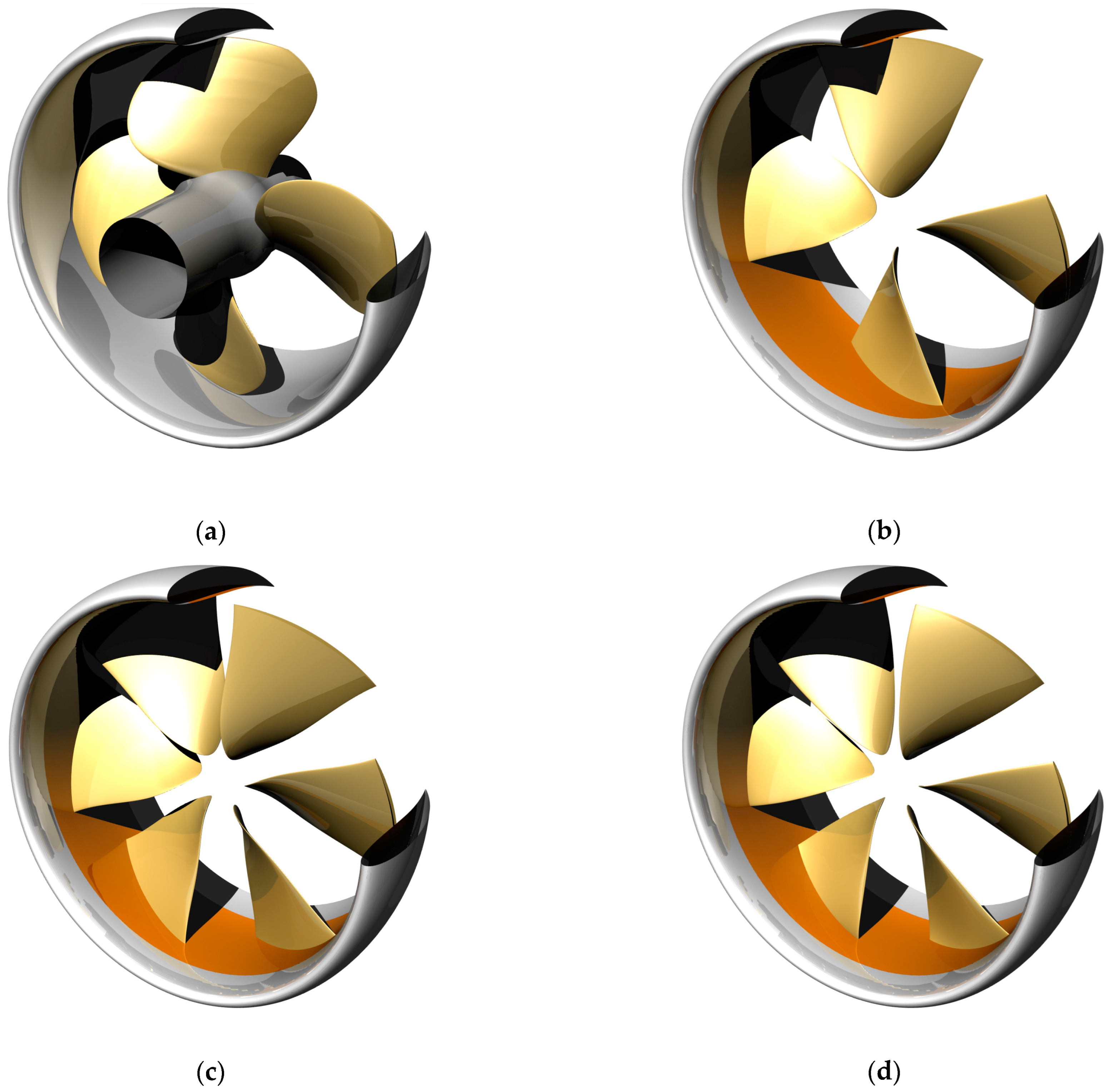


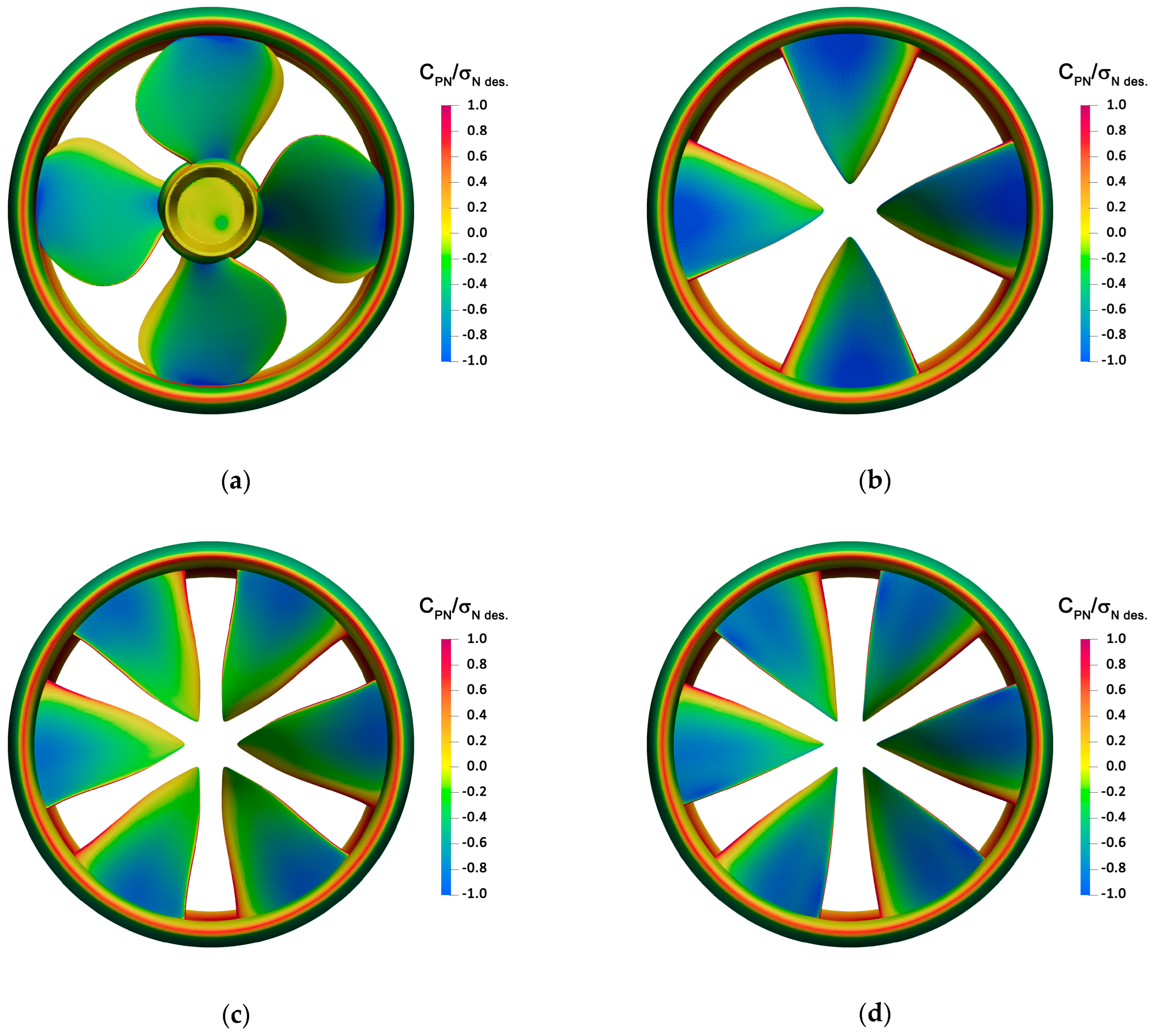
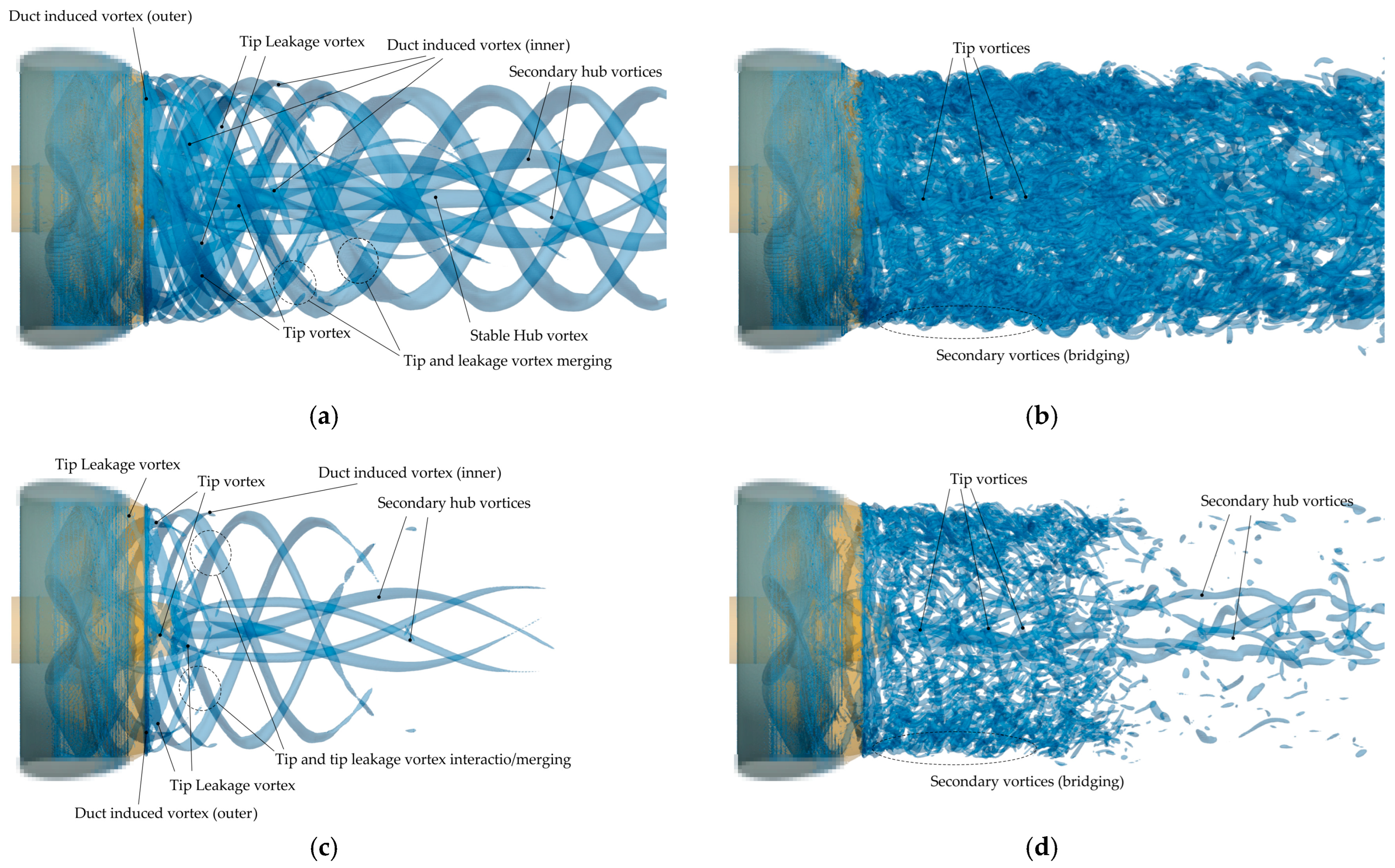








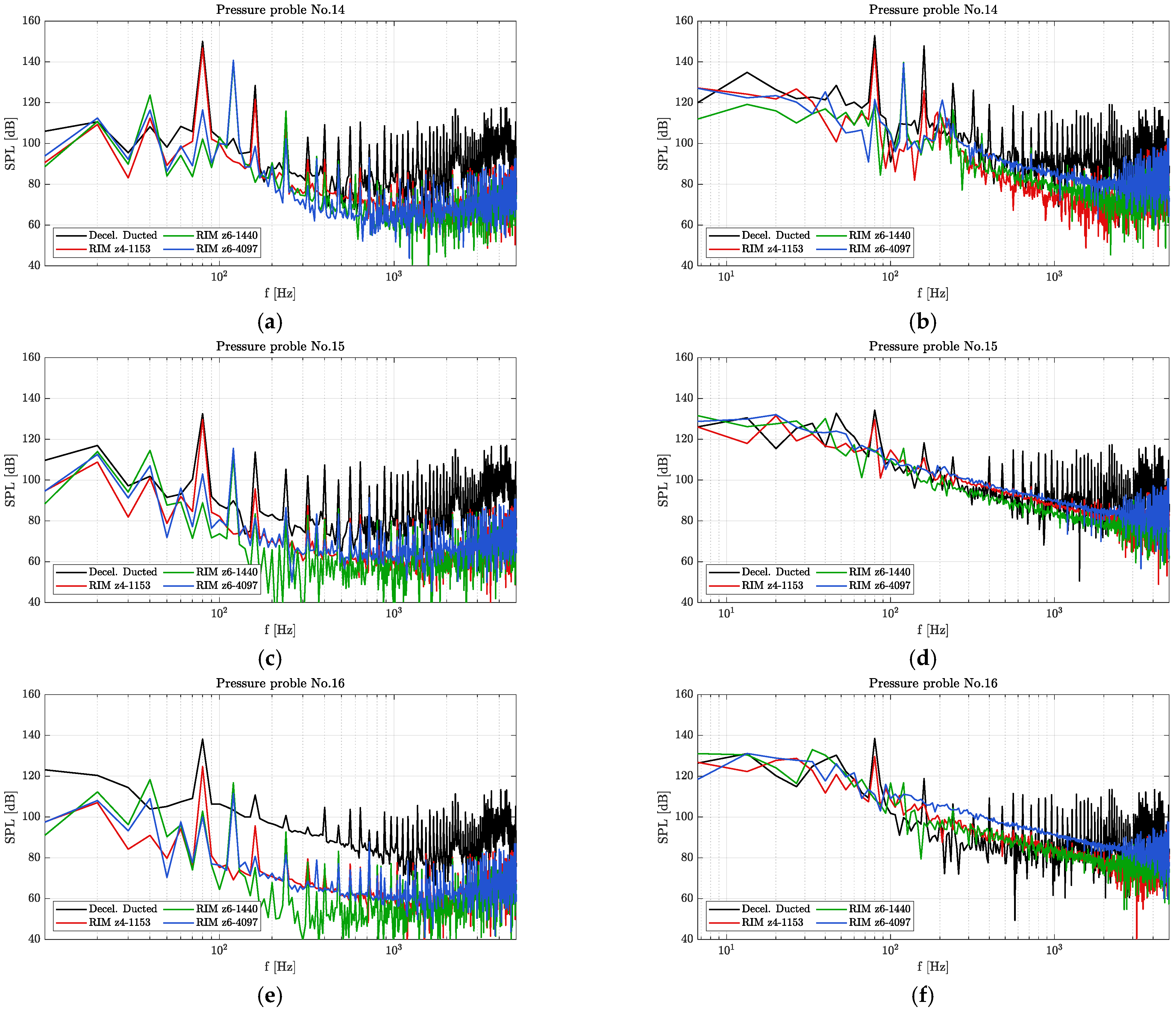
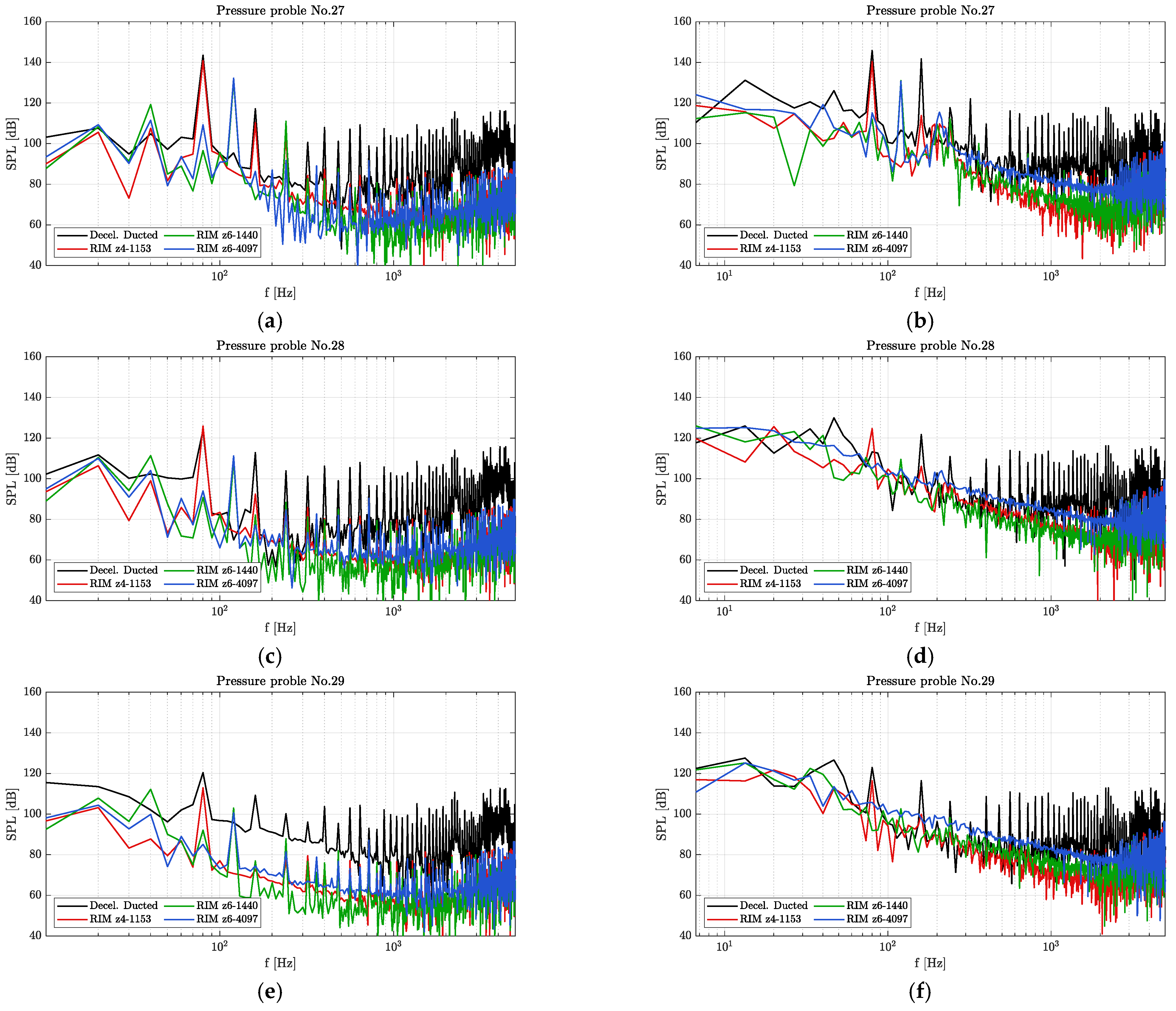
| Reference | z4–1153 | z6–1440 | z6–4067 | |
|---|---|---|---|---|
| Number of blades | 4 | 4 | 6 | 6 |
| Diameter (model scale) | 0.23 m | 0.23 m | 0.23 m | 0.23 m |
| rhub/R | 0.30 | - | - | - |
| AE/AO | 0.725 | 0.606 | 0.789 | 0.728 |
| c/D 0.7R | 0.498 | 0.341 | 0.285 | 0.277 |
| fmax/c 0.7R | 0.0246 | 0.0186 | 0.0156 | 0.0191 |
| P/D 0.7R | 1.354 | 1.098 | 1.077 | 1.166 |
| Patch | Velocity | Pressure | ||
|---|---|---|---|---|
| Inlet | Fixed | |||
| Outlet | ) | |||
| Blades, Nozzle (hub, shaft) | No-slip | 0 with wallfunction (kqRWallFunction) | 0 with wallfunction (nutUspaldingWallFunction) | |
| Lateral cylindrical surface | No-slip | |||
| Inner rotating/outer fixed region interface | Arbitrary Mesh Interface (AMI) | Arbitrary Mesh Interface (AMI) | Arbitrary Mesh Interface (AMI) | Arbitrary Mesh Interface (AMI) |
| Scheme | |
|---|---|
| Time | |
| Divergence | 2nd order for momentum (linearUpwind) 2nd order for turbulence (limitedLinear with Sweby limiter) |
| Gradients | Gauss with multi-dimensional limiter (cellMDLimited) |
| Laplacian | Gauss with linear interpolation and a limiter |
| Grid | Cells | KT | 10KQ | |
|---|---|---|---|---|
| Coarse | 12,824,496 | 94.20% | 105.52% | 0.581 |
| Medium | 21,026,812 | 94.45% | 104.92% | 0.586 |
| Fine (Reference) | 43,660,170 | 94.93% | 104.55% | 0.591 |
| Reference Ducted | z4–1153 | z6–1440 | z6–4097 | |||||||||
|---|---|---|---|---|---|---|---|---|---|---|---|---|
| KT | 10KQ | KT | 10KQ | KT | 10KQ | KT | 10KQ | |||||
| RANSE | 100.5% | 106.4% | 0.615 | 98.4% | 105.4% | 0.608 | 97.5% | 109.2% | 0.581 | 98.8% | 106.9% | 0.602 |
| IDDES | 96.7% | 103.7% | 0.607 | 94.5% | 103.1% | 0.597 | 92.5% | 105.5% | 0.571 | 94.9% | 104.5% | 0.591 |
Disclaimer/Publisher’s Note: The statements, opinions and data contained in all publications are solely those of the individual author(s) and contributor(s) and not of MDPI and/or the editor(s). MDPI and/or the editor(s) disclaim responsibility for any injury to people or property resulting from any ideas, methods, instructions or products referred to in the content. |
© 2023 by the author. Licensee MDPI, Basel, Switzerland. This article is an open access article distributed under the terms and conditions of the Creative Commons Attribution (CC BY) license (https://creativecommons.org/licenses/by/4.0/).
Share and Cite
Gaggero, S. A Study on the Wake Evolution of a Set of RIM-Driven Thrusters. J. Mar. Sci. Eng. 2023, 11, 1659. https://doi.org/10.3390/jmse11091659
Gaggero S. A Study on the Wake Evolution of a Set of RIM-Driven Thrusters. Journal of Marine Science and Engineering. 2023; 11(9):1659. https://doi.org/10.3390/jmse11091659
Chicago/Turabian StyleGaggero, Stefano. 2023. "A Study on the Wake Evolution of a Set of RIM-Driven Thrusters" Journal of Marine Science and Engineering 11, no. 9: 1659. https://doi.org/10.3390/jmse11091659
APA StyleGaggero, S. (2023). A Study on the Wake Evolution of a Set of RIM-Driven Thrusters. Journal of Marine Science and Engineering, 11(9), 1659. https://doi.org/10.3390/jmse11091659






